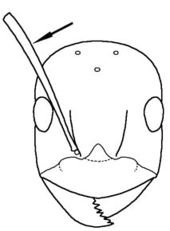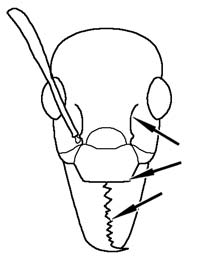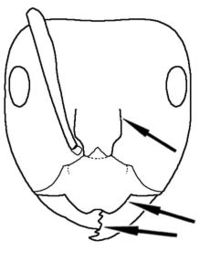Key to Formicinae genera of the southwestern Australian Botanical Province
This key to workers is based on: Heterick, B. E. 2009a. A guide to the ants of South-western Australia. Records of the Western Australian Museum, Supplement 76: 1-206. Part 1.
You may also be interested in
1
- Antenna with 10 or 11 segments (including the scape) . . . . . 2
- Antenna with 12 segments (including the scape) . . . . . 4
2
return to couplet #1
- Palps short (PF 2,3) (Figure 51); eyes minute; soft-looking, yellowish ants with large gaster (SW species rarely collected, probably spends most of its life underground; also in the Kimberley region) . . . . . Acropyga
- Palps long (PF 6,4) (Figure 52); eyes normal size; other features variable . . . . . 3
3
return to couplet #2
- Propodeum with one or more pairs of spines, teeth or protuberances, often including pair over propodeal spiracle; petiolar node often with pair of spines or lateral processes (Figure 53) . . . . . Stigmacros
- Propodeum and petiolar node always without spines, teeth or protuberances. (Figure 54) . . . . . Plagiolepis
4
return to couplet #1
- Lower corner of mesosoma below propodeum without an opening (to the metapleural gland) fringed with long setae, though a few scattered setae may be present (Figure 55) . . . . . 5
- Lower corner of mesosoma below propodeum, just above hind coxa, with an opening that is often fringed with long hairs (Figure 56) . . . . . 6
5
return to couplet #4
- Upper plate of first gastral segment (first tergite) approximately half total length of gaster; spines or sharp angles present on propodeum and petiolar node (Figure 57); one worker caste . . . . . Polyrhachis
- Upper plate of first gastral segment much less than half total length of gaster; spines always absent on body segments in West Australian species; propodeal angle (if present) rounded (Figure 58); major and minor worker castes, at least, always present, media workers often present . . . . . Camponotus / Colobopsis
6
return to couplet #4
- Eyes very large and placed on posterior corners of head capsule (Figure 59) . . . . . Opisthopsis (There is a single species present: Opisthopsis rufithorax)
- Eyes of moderate size and placed at sides or front of head capsule, but not near posterior corners (Figure 60) . . . . . 7
7
return to couplet #6
- Antennal sockets separated from the posterior margin of the clypeus by a distance greater than the smallest diameter of the antennal scape (Figure 61) . . . . . Calomyrmex
- Antennal sockets very close to posterior margin of the clypeus separated, at most, by a distance less than the smallest diameter of the antennal scape (Figure 62) . . . . . 8
8
return to couplet #7
- Propodeal spiracle slit or comma-like (Figure 63a); clypeus and underside of head and mandibles usually with profuse, long, curved hairs (Figure 63b); major, media and minor castes present (i.e. species polymorphic); species very active in the heat of the day . . . . . Melophorus
- Propodeal spiracle oval or round (Figure 64); clypeus and underside of head and mandibles with few or no long curved hairs; single worker caste (i.e. species monomorphic) . . . . . 9
9
return to couplet #8
- Dorsum of head, pronotum and mesonotum, at least, with multiple conspicuously paired, stout, dark setae (the latter also present on propodeum in P. minutula group) (Figure 65); ocelli very small to absent in WA species . . . . . Paratrechina / Paraparatrechina / Nylanderia
- Dorsum of head, pronotum and mesonotum usually with well-separated, thin, pale setae (Figure 66) (setae sometimes lacking), but if stout and dark, then maximum of one or two conspicuously paired pairs on pronotum (Figure 67); two or three ocelli placed in a triangle usually evident . . . . . 10
10
return to couplet #9
- Propodeal spiracle located near posterior face of propodeum (Figure 68a); antennal scapes exceed posterior margin of head capsule by more than one third of their length (Figure 68b); outline of mesosoma smooth . . . . . Prolasius
- Propodeal spiracle located at least its diameter anterior of the posterior face of the propodeum (Figure 69); antennal scapes exceed posterior margin of head capsule by less than one third of their length (Figure 70); mesosoma often with processes on pronotum . . . . . 11
11
return to couplet #10
- Projecting central anterior margin of clypeus rectangular; frontal carinae distinctly arched; mandible with 10–13 teeth in minors, as few as six in majors; frontal carinae strongly arched (Figure 71); workers polymorphic; dorsum of mesosoma always smooth in outline (rare, SW and eastern wheatbelt) . . . . . Myrmecorhynchus (There is a single species present: Myrmecorhynchus emeryi)
- Anterior margin of clypeus convex or sinuate in outline, often with a central notch or groove; mandibles with six or seven teeth; frontal carina weakly arched or straight (Figure 72); workers monomorphic in Western Australian species (one or more Eastern states species weakly polymorphic); dorsum of mesosoma may have angular or rounded pronotal and metanotal processes . . . . . Notoncus






















